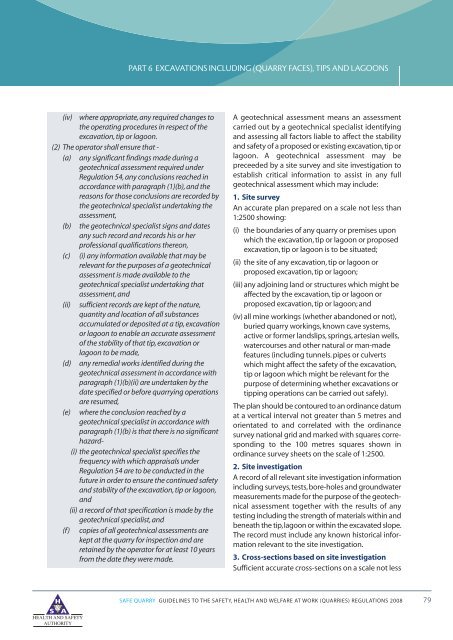Safe Quarry - Health and Safety Authority
Safe Quarry - Health and Safety Authority
Safe Quarry - Health and Safety Authority
Create successful ePaper yourself
Turn your PDF publications into a flip-book with our unique Google optimized e-Paper software.
PART 6 EXCAVATIONS INCLUDING (QUARRY FACES), TIPS AND LAGOONS<br />
(iv) where appropriate, any required changes to<br />
the operating procedures in respect of the<br />
excavation, tip or lagoon.<br />
(2) The operator shall ensure that -<br />
(a) any significant findings made during a<br />
geotechnical assessment required under<br />
Regulation 54, any conclusions reached in<br />
accordance with paragraph (1)(b), <strong>and</strong> the<br />
reasons for those conclusions are recorded by<br />
the geotechnical specialist undertaking the<br />
assessment,<br />
(b) the geotechnical specialist signs <strong>and</strong> dates<br />
any such record <strong>and</strong> records his or her<br />
professional qualifications thereon,<br />
(c) (i) any information available that may be<br />
relevant for the purposes of a geotechnical<br />
assessment is made available to the<br />
geotechnical specialist undertaking that<br />
assessment, <strong>and</strong><br />
(ii) sufficient records are kept of the nature,<br />
quantity <strong>and</strong> location of all substances<br />
accumulated or deposited at a tip, excavation<br />
or lagoon to enable an accurate assessment<br />
of the stability of that tip, excavation or<br />
lagoon to be made,<br />
(d) any remedial works identified during the<br />
geotechnical assessment in accordance with<br />
paragraph (1)(b)(ii) are undertaken by the<br />
date specified or before quarrying operations<br />
are resumed,<br />
(e) where the conclusion reached by a<br />
geotechnical specialist in accordance with<br />
paragraph (1)(b) is that there is no significant<br />
hazard-<br />
(i) the geotechnical specialist specifies the<br />
frequency with which appraisals under<br />
Regulation 54 are to be conducted in the<br />
future in order to ensure the continued safety<br />
<strong>and</strong> stability of the excavation, tip or lagoon,<br />
<strong>and</strong><br />
(ii) a record of that specification is made by the<br />
geotechnical specialist, <strong>and</strong><br />
(f) copies of all geotechnical assessments are<br />
kept at the quarry for inspection <strong>and</strong> are<br />
retained by the operator for at least 10 years<br />
from the date they were made.<br />
A geotechnical assessment means an assessment<br />
carried out by a geotechnical specialist identifying<br />
<strong>and</strong> assessing all factors liable to affect the stability<br />
<strong>and</strong> safety of a proposed or existing excavation,tip or<br />
lagoon. A geotechnical assessment may be<br />
preceeded by a site survey <strong>and</strong> site investigation to<br />
establish critical information to assist in any full<br />
geotechnical assessment which may include:<br />
1. Site survey<br />
An accurate plan prepared on a scale not less than<br />
1:2500 showing:<br />
(i) the boundaries of any quarry or premises upon<br />
which the excavation, tip or lagoon or proposed<br />
excavation, tip or lagoon is to be situated;<br />
(ii) the site of any excavation, tip or lagoon or<br />
proposed excavation, tip or lagoon;<br />
(iii) any adjoining l<strong>and</strong> or structures which might be<br />
affected by the excavation, tip or lagoon or<br />
proposed excavation, tip or lagoon; <strong>and</strong><br />
(iv) all mine workings (whether ab<strong>and</strong>oned or not),<br />
buried quarry workings, known cave systems,<br />
active or former l<strong>and</strong>slips, springs, artesian wells,<br />
watercourses <strong>and</strong> other natural or man-made<br />
features (including tunnels. pipes or culverts<br />
which might affect the safety of the excavation,<br />
tip or lagoon which might be relevant for the<br />
purpose of determining whether excavations or<br />
tipping operations can be carried out safely).<br />
The plan should be contoured to an ordinance datum<br />
at a vertical interval not greater than 5 metres <strong>and</strong><br />
orientated to <strong>and</strong> correlated with the ordinance<br />
survey national grid <strong>and</strong> marked with squares corresponding<br />
to the 100 metres squares shown in<br />
ordinance survey sheets on the scale of 1:2500.<br />
2. Site investigation<br />
A record of all relevant site investigation information<br />
including surveys,tests,bore-holes <strong>and</strong> groundwater<br />
measurements made for the purpose of the geotechnical<br />
assessment together with the results of any<br />
testing including the strength of materials within <strong>and</strong><br />
beneath the tip,lagoon or within the excavated slope.<br />
The record must include any known historical information<br />
relevant to the site investigation.<br />
3. Cross-sections based on site investigation<br />
Sufficient accurate cross-sections on a scale not less<br />
SAFE QUARRY GUIDELINES TO THE SAFETY, HEALTH AND WELFARE AT WORK (QUARRIES) REGULATIONS 2008 79
















